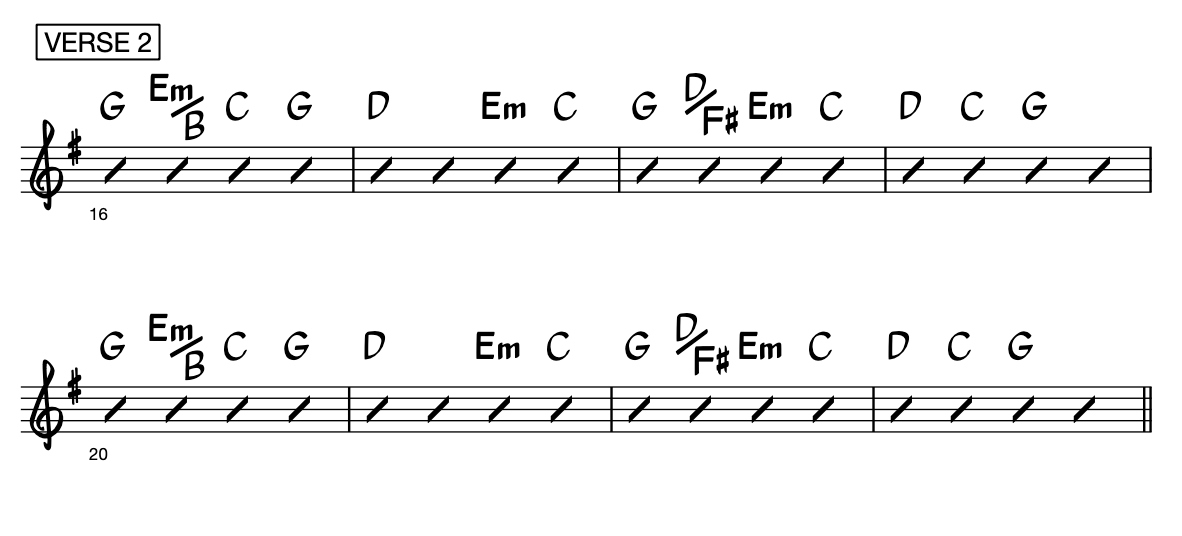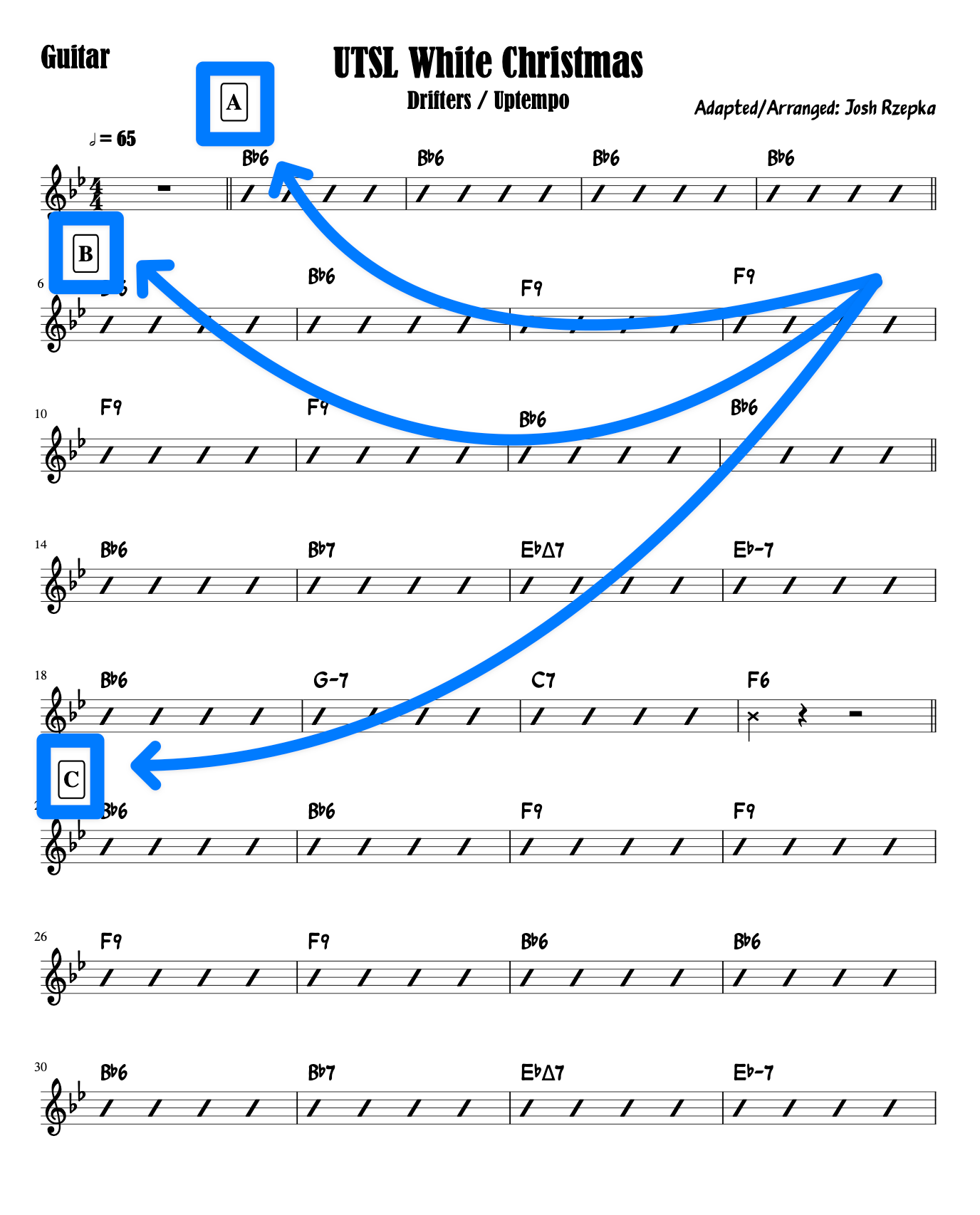🟢 Start here.
(a new series for May)
I’ve sent more than one hundred issues.
We’ve covered a ton of hands-on theory ideas.
Useful ideas, drawn from real songs.
For the next four-ish weeks, I’d like to recap the most important things we’ve learned in the past two+ years of Riffs, Recs, Charts & Smarts.
We’ll cover:
FORM
MEASURES
METER
CHORDS
KEYS
RHYTHMS
CONVENTIONS
Let’s kick it off this week with the most straightforward & useful music theory of all.
When we talk about music theory, we tend to get spun up in our minds.
What notes are in a Bbm7b5?
What scale can I use to solo over Fmaj7#11?
But for the most part, music theory is just giving names to commonly occurring things.
Those names help us do two main things:
communicate with other musicians
organize our thinking
The most basic aspect of music theory is naming the sections of songs: intro, verse, chorus, bridge.
It’s helpful when we communicate with our bandmates:
Can you give me a different groove for the CHORUS?
Let’s take it again from the top of the BRIDGE.
I’m gonna lay out for the first VERSE and enter at the second.
And it’s also useful to help organize your thinking about a song’s form:
Oh, that last VERSE isn’t a verse at all—it’s its own thing.
I solo over the CHORUS progression on this one.
This song goes Verse Verse Chorus Verse Chorus Bridge Chorus Tag.
These terms aren’t set in stone, and you might see some variations or call it something different than the next person. That’s ok.
INTRO
The INTRO is thing that happens before the meat of the song.
The intro is often instrumental—a riff, a chord swell, a drum beat, or a melody.
Sometimes it’s the most iconic part of the song (When Doves Cry and Let’s Go Crazy are prime examples).
Other times the world collectively decides that the song would be better off without the intro
(For example, did you know there’s a whole other section before “I’m dreaming of a white Christmas”?)
(Same thing for “take me out to the ballgame…”)
Frequently the riff or melody from intro will be repeated later in the song. When that happens, I like to label it RE INTRO.
VERSE
The VERSE is where the story of the song gets told.
The melody & chords are usually the same from one verse to the next, but the lyrics change:
“Left a good job in the city” in the first verse of Proud Mary becomes…
“Cleaned a lot of plates in Memphis” in the second verse and…
“If you go down to the river” in the third.
Other times, verses will keep the same chords but use a new melody.
But not every verse is exactly the same as its siblings.
Maybe one is shorter or longer,
maybe one has slightly different chords or rhythmic hits,
or maybe one has the same chords but uses a new melody.
In these cases, it’s usually enough to label them VERSE 1 and VERSE 2, etc.
For example, check out the difference between VERSE 2 and VERSE 3 in It’s A Great Day To Be Alive:
CHORUS
The CHORUS is the song’s most anthemic section:
it’s the part that everyone knows the words to,
the part that gets repeated throughout the song,
including maybe two or three times in a row at the end.
Generally speaking, the words don’t change from one chorus to the next, (but they might).
The chorus is usually louder & more intense than the verse (though songs like Karma Police invert that relationship to great effect):
In a song where the chords & melody are the same between the chorus and the verse, the chorus is the one where the lyrics are the same each time through.
For example, this is a VERSE from Give Me One Reason:
And this—with the exact same chords and groove—is the CHORUS:
REFRAIN
People tend to use “refrain” and “chorus” interchangeably, but I wish they wouldn’t.
In my mind, a refrain is a lyrical hook that gets repeated at the end of each verse.
The song might have a proper chorus that follows, or it might not.
BRIDGE
The BRIDGE’s job is to keep us from getting bored by verse-chorus-verse-chorus.
In the Beatles song Something, the VERSE starts like this:
The CHORUS is this section:
And the BRIDGE goes like this:
The bridge usually only happens once.
Lyrically, the bridge probably contains the insight or surprise (all this time he’s been singing to his wife it’s been at her graveside!).
Sometimes you’ll hear people call the bridge a “middle eight” (because 8 bars is a common length for a bridge).
Not every song has a bridge.
DOWN CHORUS / DOWN VERSE
Songs that don’t have bridges frequently use a DOWN CHORUS or DOWN VERSE.
“Down” is short for “breakdown”
It’s a dynamic change—playing quieter to keep things interesting…
…and to make the loud part that inevitably follows sound even louder.
Usually some instruments stay in but others drop out.
Maybe it’s a full verse or chorus that’s quiet…
…but usually only part of it is “down”…
…then the band returns loud and proud for the rest of it.
On a chart, we write “ALL IN” so we all know when to re-enter.
Here’s the regular Pre Chorus → Chorus in Luke Combs’ Beer Never Broke My Heart:
And here’s the DOWN section that happens a minute or so later:
INTERLUDE
An INTERLUDE is a section between the main sections.
It serves the same function as a RE INTRO
…but isn’t a repeat of the INTRO—it’s its own thing.
Sometimes it’ll just be a few bars of a chord that help set up the second verse.
A great example of an INTERLUDE is in Journey’s Faithfully:
RIFF
You know what a riff is. But should you label it?
Is the riff the thing from the INTRO?
→ Then no, just use INTRO and RE INTRO.
Is the riff its own section, independent of the VERSE, CHORUS, or INTRO?
→ Then yes, label it RIFF.
PRE CHORUS
The PRE CHORUS leads into the chorus.
We abbreviate it “PC”:
But who’s to say that it’s not just a continuation of the verse?
It’s a bit of a judgement call.
Does it feel like a new thing?
If there are two verses back-to-back, does it only happen after the second one (ie leading into the chorus)?
Would it make the chart clearer?
POST CHORUS
Is this even a thing? I think it is.
It’s a section that:
isn’t an intro/interlude
has lyrics/singing
happens after a chorus
but not after every chorus
The Billy Currington song Do I Make You Wanna has one:
CHORUS 1—“Do I make you wanna dance real slow…”
POST CHORUS—“stay up ‘til the sun… howl at the moon”
But why is it its own section? Why isn’t it just the end of the chorus?
Because check out what happens after Chorus 2:
Because it:
doesn’t happen after every chorus
and isn’t the bridge
I think we should call it sometjhing
in this case: POST CHORUS
SOLO
Pretty self explanatory—someone plays a lead.
If the solo is over another part of the form, sometimes you’ll see something like “with guitar solo 2nd time” or “Verse 1, Verse 2, Solo”
TAG
This is when you repeat the last line of the last chorus for emphasis.
Or maybe for when there’s a playful instrumental exclamation point on a tune.
Sometimes I’ll write it as TAG, other times I’ll just mark it LAST CHORUS to give a heads up that there’s something different about it.
CODA
A CODA is an ending section.
Don’t use them. They’re outdated.
Older charts used Italian “roadmap” markings:
Da Capo (go back to the beginning)
Dal Segno (go back to the sign).
DS al Coda (go back to the sign, but then jump ahead to an ending section)
This was largely done:
to save ink & pages (in commercial printings like song books),
to save the trouble of rewriting a bunch of things (in professional charts, which were handwritten), or
to try to cram a whole song onto one or two pages (so it sits nicely on a music stand and doesn’t require a page turn).
The trouble with these is that they’re too easy to miss. And if not everyone follows the Italian roadmap directions? Total onstage trainwreck.
And the problems solved by DC, DS, & al Coda aren’t real problems anymore:
save ink & pages? We’re all reading it on an iPad now.
save the trouble of rewriting? That’s what copy & paste are for.
avoids a page turn? Bluetooth page turners are just as common as the iPads they’re connected to.
To recap: a coda is an ending section of a tune, but that name is falling out of favor. Because technology.
OUTRO
Since we’re not calling it Coda, the end section of tune is an OUTRO.
Is outro even a word? Not according to the spellcheck on this computer. But it doesn’t think wah is a word either. And it thinks I meant to say that something is ducking ridiculous.
So yeah: the last section of a tune is an outro. Oftentimes it’s the thing from the intro again.
HOOK
In country & pop music, the hook is the title of the song, sung at the top and/or bottom of the anthemic chorus. It’s the most recognizable part of the tune, and the one that even your weird aunt knows the lyrics to.
In hiphop, the hook is the sung part between the rapping. It’s the guest female vocalist singing the catchy “chorus” of the song. Or maybe it’s some infectious synth line Dr. Dre plays.
You wouldn’t label a chart with HOOK in a country song (it’s just part of the chorus), but you might for a rap tune (though you might also label it “chorus”).
Either way, don’t be confused about any of the other catchy elements of a song, which are also frequently referred to as hooks.
The last measure of Rivers Cuomo’s guitar solo on Buddy Holly is absolutely a hook…
…but it’s not the hook.
REHEARSAL LETTERS
If a song has a ton of different sections, you might abandon names all together and simply label the song sections with REHEARSAL LETTERS:
This makes it easy to say things like “let’s take it again from J…” in a rehearsal.
Another variation on this is to use boxed measure numbers instead:
AABA
This is an old Tin Pan Alley thing.
Works like this:
1. - First A section—a verse ending with the refrain (“the nearness of you”).
2. Second A section—At the end of the 1st A, we take the close repeat sign at ① back to the open repeat sign at ②, and skip over the first ending to play the second ending at ③:
3. Then we play the B section—you might think of this as the bridge:
4. Then we play the last A section.
So the bandleader might say something like “Let’s take it from the second A, and then let’s watch the dynamics in the B section.”
Of course, it needn’t be vocal music with a refrain—plenty of instrumental jazz standards use it too.
The Wrap Up
So there you have it: some of the most fundamental (and useful) music theory.
Use it to communicate your ideas to your bandmates.
Use it to label your charts.
Use it to organize your thinking.
And use it to help you learn songs.
See you out there,
Josh



























Fantastic and really clear article man. Thank you for breaking all this theory/musicianship/composition down in very digestible and relatable notions. Excited to play sing write and learn more